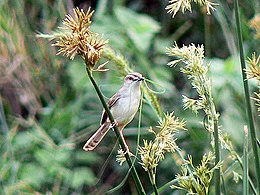Tawny-flanked prinia
| Tawny-flanked prinia | |
|---|---|

| |
| At Lake Panic, Kruger NP and calls at the Palala River, Waterberg Biosphere | |
| Scientific classification | |
| Domain: | Eukaryota |
| Kingdom: | Animalia |
| Phylum: | Chordata |
| Class: | Aves |
| Order: | Passeriformes |
| Family: | Cisticolidae |
| Genus: | Prinia |
| Species: | P. subflava
|
| Binomial name | |
| Prinia subflava (Gmelin, JF, 1789)
| |
The tawny-flanked prinia (Prinia subflava) is a small passerine bird belonging to the genus Prinia in the family Cisticolidae, a family of Old World warblers. It is widespread and common in most parts of Africa south of the Sahara. The plain prinia (P. inornata) of southern Asia was formerly included in this species but is now usually considered to be a separate species.
Taxonomy
The tawny-flanked prinia was
Ten subspecies are recognised:[5]
- P. s. subflava (Gmelin, JF, 1789) — south Mauritania and Senegal to central Ethiopia and north Uganda
- P. s. pallescens Madarász, G, 1914 — north Mali to northwest Eritrea and north Ethiopia
- P. s. tenella (Cabanis, 1868) — south Somalia, east Kenya and east Tanzania
- P. s. melanorhyncha (Jardine & Fraser, 1852) — Sierra Leone to south Uganda, central Kenya and northwest Tanzania
- P. s. graueri Hartert, EJO, 1920 — central Angola, south, east DR Congo and Rwanda
- P. s. affinis (Smith, A, 1843) — southeast DR Congo and southwest Tanzania to northeast South Africa
- P. s. kasokae White, CMN, 1946 — east Angola and west Zambia
- P. s. mutatrix Meise, 1936 — south Tanzania to east Zimbabwe and central Mozambique
- P. s. bechuanae Macdonald, 1941 — southwest Angola and north Namibia to northwest Zimbabwe
- P. s. pondoensis Roberts, 1922 — south Mozambique and east South Africa
Description
The tawny-flanked prinia is 11–12 cm (4.3–4.7 in) in length with a long, narrow, graduated tail
The sexes are similar in appearance. Non-breeding birds have a longer tail than breeding birds. Juveniles have pale yellow underparts and a yellowish bill. There are many recognised subspecies.
The call is short, wheezy and rapidly repeated. The
The pale prinia (P. somalica) of North-east Africa is similar but paler and greyer with whitish flanks. It inhabits drier, more open habitats than the tawny-flanked prinia. The river prinia (P. fluviatilis) of West Africa is also paler and greyer and has a longer tail. It is restricted to waterside vegetation.
Distribution and habitat
There are ten subspecies distributed across most parts of sub-Saharan Africa except for the driest and wettest areas. It is absent from much of the Congo Basin, southern Namibia, south-west Botswana and the western half of South Africa. It is found amongst shrubs and grass in a variety of habitats including woodland, savanna and cultivated areas. It adapts well to man-made habitats and is not considered to be threatened.
Behaviour
It feeds on insects and other invertebrates. It forages in small flocks which move through shrubs and undergrowth.
The
Gallery
-
P. s. bechuanae with nesting material, Namibia
-
Juvenile P. s. melanorhyncha, Soysambu Conservancy, Kenya
-
Collecting nest material in Kruger National Park
References
- . Retrieved 12 November 2021.
- ^ Gmelin, Johann Friedrich (1789). Systema naturae per regna tria naturae : secundum classes, ordines, genera, species, cum characteribus, differentiis, synonymis, locis (in Latin). Vol. 1, Part 2 (13th ed.). Lipsiae [Leipzig]: Georg. Emanuel. Beer. p. 982.
- ISBN 978-1-4081-2501-4.
- Daubenton, Louis-Jean-Marie (1765–1783). "Figuier blond de Sénégal". Planches Enluminées D'Histoire Naturelle. Vol. 6. Paris: De L'Imprimerie Royale. Plate 584, Fig. 2.
- ^ Rasmussen, Pamela, eds. (January 2023). "Grassbirds, Donacobius, tetrakas, cisticolas, allies". IOC World Bird List Version 13.1. International Ornithologists' Union. Retrieved 24 May 2023.
- ISBN 978-84-96553-06-4.
- Barlow, Clive; Wacher, Tim & Disley, Tony (1999) A Field Guide to Birds of the Gambia and Senegal, Pica Press, Sussex.
- Serle, W.; Morel G.J. & Hartwig, W. (1977) Collins Field Guide: Birds of West Africa, HarperCollins.
- Sinclair, Ian & Ryan, Peter (2003) Birds of Africa south of the Sahara, Struik, Cape Town.
- Zimmerman, Dale A.; Turner, Donald A. & Pearson, David J. (1999) Birds of Kenya & Northern Tanzania, Christopher Helm, London.
External links
- African Bird Image Database: Tawny-flanked prinia
- Tawny-flanked prinia - Species text in The Atlas of Southern African Birds.




